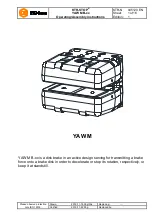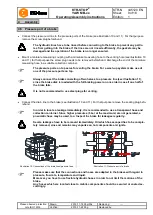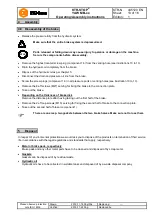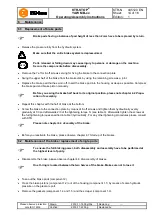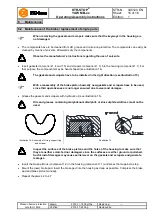
KTR-STOP
®
YAW M B-xx
Operating/Assembly instructions
KTR-N
Sheet:
Edition:
445120 EN
12 of 16
1
Please observe protection
note ISO 16016.
Drawn:
2019-11-18 Shg/Wie
Replacing:
---
Verified:
2019-11-22 Shg
Replaced by:
You may only use mineral hydraulic liquids meeting the demands of DIN 51524. KTR
recommends those liquids corresponding to DIN 51524-3.
KTR recommends the following liquids (other manufacturers may be selected):
Manufacturer
Standard
Special
Mineral oil
-20 °C to +40 °C
(- 4 °F to 104 °F)
+10 °C to +60 °C
(+ 50 °F to + 140 °F)
-30 °C to +20 °C
(- 22 °F to 68 °F)
+30 °C to 70 °C
(+ 86 °F to + 158 °F)
Castrol
Hyspin HVI 32
Hyspin HVI 46
-
Hyspin HVI 68
Shell
Tellus S2 VX32
Tellus S2 VX46
Tellus S4 VX32
Tellus S2 VX68
Mobil
DTE 10 Excel 32
DTE 10 Excel 46
-
DTE 10 Excel 68
The permissible operating temperatures from -20 °C to +50 °C (-4 °F to +122 °F) of the brake
components have to be adhered to. For deviating operating temperatures please consult
with KTR.
Viscosity
We would recommend a viscosity range from 20 to 220 mm²/s (cSt) of the hydraulic liquid with operating tempera-
ture.
The viscosity during starting should not exceed 500 mm²/s and the viscosity during operation should not fall below
12 mm²/s.
Filtration
When filling and re-filling the hydraulic system and replacing the hydraulic liquid, the oil needs to be filtered. For
that purpose use an offline filter or a respective fill unit. In addition we would recommend to use an inline filter.
The service life of the brake system is extended depending on the degree of purity of the oil.
The KTR hydraulic systems are provided with a 10-µm inline filter as a standard.
In order to ensure the reliability of the system, only oils originating from the following purity classes are permitted:
•
ISO 4406, class 18/16/13
Maintenance operations on the hydraulic system
In order to ensure smooth operation of the overall system, the maintenance operations on the hydraulic system
(inspection of level and degree of dirt, replacing the hydraulic liquid or filter elements, etc.) have to be performed
as per the manufacturer's operating instructions.
The system has to be rinsed or vented after each replacement of the hydraulic liquid.
!
Adverse reactions may be generated by mixing different liquids or liquids of various manu-
facturers.
Please contact the manufacturer of mineral oils if you intend to replace the hydraulic liquid.
4
Assembly
4.8 Recommendation of liquids to be used

